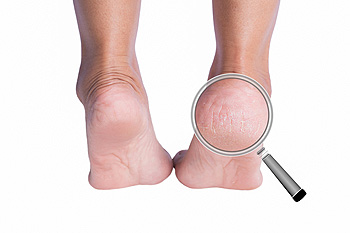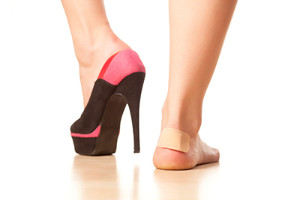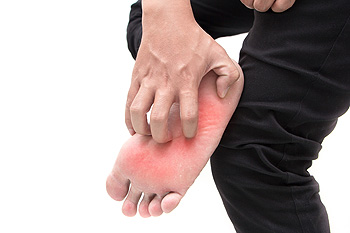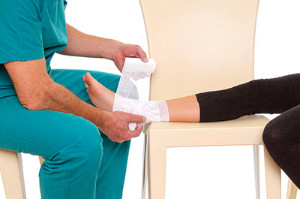September 2019
Causes Of Cracked Heels
 Patients who have cracked heels are often familiar with the pain and discomfort this condition may cause. Fissures are deep cracks in the skin that develop on the outer edge of the heels and may occur due to a variety of reasons. Common causes can include wearing shoes that have an open back and standing for extended periods of time throughout the day. Additionally, obesity may play a significant role in the development of cracked heels. Fortunately, there are measures that may help prevent this condition. These can include limiting the time standing, avoiding vitamin deficiencies, and wearing shoes that have ample cushioning in the heel area. If you are experiencing this ailment, speak to a podiatrist who can provide you with proper treatment techniques.
Patients who have cracked heels are often familiar with the pain and discomfort this condition may cause. Fissures are deep cracks in the skin that develop on the outer edge of the heels and may occur due to a variety of reasons. Common causes can include wearing shoes that have an open back and standing for extended periods of time throughout the day. Additionally, obesity may play a significant role in the development of cracked heels. Fortunately, there are measures that may help prevent this condition. These can include limiting the time standing, avoiding vitamin deficiencies, and wearing shoes that have ample cushioning in the heel area. If you are experiencing this ailment, speak to a podiatrist who can provide you with proper treatment techniques.
If the skin on your feet starts to crack, you may want to see a podiatrist to find treatment. If you have any concerns, contact Dr. Lee R. Stein from Lake Shore Foot & Ankle, PC. Our doctor can provide the care you need to keep you pain-free and on your feet.
Cracked Heels
It is important to moisturize your cracked heels in order to prevent pain, bleeding, and infection. The reason cracked heels form is because the skin on the foot is too dry to support the immense pressure placed on them. When the foot expands, the dry skin on the foot begins to split.
Ways to Help Heal Them
- Invest in a good foot cream
- Try Using Petroleum Jelly
- Ease up on Soaps
- Drink Plenty of Water
Ways to Prevent Cracked Heels
- Moisturize After Showering
- Skip a Shower
- Keep Shower Water Lukewarm
- Don’t Scrub Your Feet
If you are unsure how to proceed in treating cracked heels, seek guidance from a podiatrist. Your doctor will help you with any questions or information you may need.
If you have any questions, please feel free to contact one of our offices located in Chicago, Highland Park, and Uptown, IL . We offer the newest diagnostic and treatment technologies for all your foot care needs.
What Does Wearing High Heels Do To The Feet?
 Research has indicated that wearing shoes with heels can play a significant role in foot and ankle injuries. Wearing this type of shoe may cause joint pain, and this may be a result of the structure of the shoe. Bunions may develop gradually when the toes are squeezed into a pointed shoe that does not have adequate room for the toes to move freely in. Additionally, the back of the calf may be affected when high heels are frequently worn. Symptoms of this may include pain and stiffness in the Achilles tendon. Ingrown toenails may develop when the toes are crammed together while wearing high heels. Falling may increase which may lead to ankle sprains or fractures. If you would like additional information about the effects of high heels on your feet, it is suggested that you consult with a podiatrist.
Research has indicated that wearing shoes with heels can play a significant role in foot and ankle injuries. Wearing this type of shoe may cause joint pain, and this may be a result of the structure of the shoe. Bunions may develop gradually when the toes are squeezed into a pointed shoe that does not have adequate room for the toes to move freely in. Additionally, the back of the calf may be affected when high heels are frequently worn. Symptoms of this may include pain and stiffness in the Achilles tendon. Ingrown toenails may develop when the toes are crammed together while wearing high heels. Falling may increase which may lead to ankle sprains or fractures. If you would like additional information about the effects of high heels on your feet, it is suggested that you consult with a podiatrist.
High heels have a history of causing foot and ankle problems. If you have any concerns about your feet or ankles, contact Dr. Lee R. Stein from Lake Shore Foot & Ankle, PC. Our doctor can provide the care you need to keep you pain-free and on your feet.
Effects of High Heels on the Feet
High heels are popular shoes among women because of their many styles and societal appeal. Despite this, high heels can still cause many health problems if worn too frequently.
Which Parts of My Body Will Be Affected by High Heels?
- Ankle Joints
- Achilles Tendon – May shorten and stiffen with prolonged wear
- Balls of the Feet
- Knees – Heels cause the knees to bend constantly, creating stress on them
- Back – They decrease the spine’s ability to absorb shock, which may lead to back pain. The vertebrae of the lower back may compress.
What Kinds of Foot Problems Can Develop from Wearing High Heels?
- Corns
- Calluses
- Hammertoe
- Bunions
- Morton’s Neuroma
- Plantar Fasciitis
How Can I Still Wear High Heels and Maintain Foot Health?
If you want to wear high heeled shoes, make sure that you are not wearing them every day, as this will help prevent long term physical problems. Try wearing thicker heels as opposed to stilettos to distribute weight more evenly across the feet. Always make sure you are wearing the proper shoes for the right occasion, such as sneakers for exercising. If you walk to work, try carrying your heels with you and changing into them once you arrive at work. Adding inserts to your heels can help cushion your feet and absorb shock. Full foot inserts or metatarsal pads are available.
If you have any questions please feel free to contact one of our offices located in Chicago, Highland Park, and Uptown, IL . We offer the newest diagnostic and treatment technologies for all your foot and ankle needs.
Where Does The Fungus That Causes Athlete’s Foot Live?
 The most common type of skin infection caused by a fungus is referred to as athlete’s foot. This fungus lives and thrives in warm and moist environments that often consist of public pools, shower room floors, locker rooms and surrounding areas. Noticeable symptoms that often accompany this condition can include severe itchiness on the soles of the feet, between the toes, and the skin may crack and appear scaly. If you are affected by athlete’s foot, moderate relief can be found when an antifungal medication is used. This can be applied in the form of a spray, cream, or lotion. There are methods that can be taken which may help to prevent contracting this condition. These can include wearing appropriate shoes while in moist environments, in addition to keeping your feet clean and dry. If you are afflicted with a severe case of athlete’s foot, it is strongly suggested that you consult with a podiatrist who can properly treat this condition.
The most common type of skin infection caused by a fungus is referred to as athlete’s foot. This fungus lives and thrives in warm and moist environments that often consist of public pools, shower room floors, locker rooms and surrounding areas. Noticeable symptoms that often accompany this condition can include severe itchiness on the soles of the feet, between the toes, and the skin may crack and appear scaly. If you are affected by athlete’s foot, moderate relief can be found when an antifungal medication is used. This can be applied in the form of a spray, cream, or lotion. There are methods that can be taken which may help to prevent contracting this condition. These can include wearing appropriate shoes while in moist environments, in addition to keeping your feet clean and dry. If you are afflicted with a severe case of athlete’s foot, it is strongly suggested that you consult with a podiatrist who can properly treat this condition.
Athlete’s Foot
Athlete’s foot is often an uncomfortable condition to experience. Thankfully, podiatrists specialize in treating athlete’s foot and offer the best treatment options. If you have any questions about athlete’s foot, consult with Dr. Lee R. Stein from Lake Shore Foot & Ankle, PC. Our doctor will assess your condition and provide you with quality treatment.
What Is Athlete’s Foot?
Tinea pedis, more commonly known as athlete’s foot, is a non-serious and common fungal infection of the foot. Athlete’s foot is contagious and can be contracted by touching someone who has it or infected surfaces. The most common places contaminated by it are public showers, locker rooms, and swimming pools. Once contracted, it grows on feet that are left inside moist, dark, and warm shoes and socks.
Prevention
The most effective ways to prevent athlete’s foot include:
- Thoroughly washing and drying feet
- Avoid going barefoot in locker rooms and public showers
- Using shower shoes in public showers
- Wearing socks that allow the feet to breathe
- Changing socks and shoes frequently if you sweat a lot
Symptoms
Athlete’s foot initially occurs as a rash between the toes. However, if left undiagnosed, it can spread to the sides and bottom of the feet, toenails, and if touched by hand, the hands themselves. Symptoms include:
- Redness
- Burning
- Itching
- Scaly and peeling skin
Diagnosis and Treatment
Diagnosis is quick and easy. Skin samples will be taken and either viewed under a microscope or sent to a lab for testing. Sometimes, a podiatrist can diagnose it based on simply looking at it. Once confirmed, treatment options include oral and topical antifungal medications.
If you have any questions, please feel free to contact one of our offices located in Chicago, Highland Park, and Uptown, IL . We offer the newest diagnostic and treatment technologies for all your foot care needs.
Plantar Warts Can Be Treated!
What Is A Podiatrist?
 If you are experiencing an ailment that is related to the feet, you would most likely seek the professional advice of a podiatrist. This type of physician’s expertise is in the care of the feet and ankles, and many podiatrists can perform foot and ankle surgery. People that choose this type of profession will typically complete three years of residency training, preceded by obtaining a bachelor's degree. Podiatrists have the choice to own or be a part of an office practice, or to specialize in specific types of foot surgery. Additionally, podiatrists have the ability to create custom made orthotics which may be beneficial in correcting certain foot ailments. If you are interested in pursuing podiatry as a career choice, it is strongly suggested that you speak to a podiatrist who can address any concerns you may have.
If you are experiencing an ailment that is related to the feet, you would most likely seek the professional advice of a podiatrist. This type of physician’s expertise is in the care of the feet and ankles, and many podiatrists can perform foot and ankle surgery. People that choose this type of profession will typically complete three years of residency training, preceded by obtaining a bachelor's degree. Podiatrists have the choice to own or be a part of an office practice, or to specialize in specific types of foot surgery. Additionally, podiatrists have the ability to create custom made orthotics which may be beneficial in correcting certain foot ailments. If you are interested in pursuing podiatry as a career choice, it is strongly suggested that you speak to a podiatrist who can address any concerns you may have.
If you are dealing with pain in your feet and ankles, you may want to seek help from a podiatrist. Feel free to contact Dr. Lee R. Stein from Lake Shore Foot & Ankle, PC. Our doctor can provide the care you need to keep you pain-free and on your feet.
What Is a Podiatrist?
A podiatrist is a doctor of podiatric medicine who diagnoses and treats conditions of the foot, ankle, and related structures of the leg. Your podiatrist may specialize in a certain field such as sports medicine, wound care, pediatrics, and diabetic care. Podiatrists have the ability to become board certified through training, clinical experience, and then taking an exam.
What Do Podiatrists Do?
On a daily basis, a podiatrist may perform the following activities:
- Diagnose foot ailments such as ulcers, tumors, fractures, etc.
- Use innovative methods to treat conditions
- Use corrective orthotics, casts, and strappings to correct deformities
- Correct walking patterns and balance
- Provide individual consultations to patients
It is very important that you take care of your feet. It’s easy to take having healthy feet for granted, however foot problems tend to be among the most common health conditions. Podiatrists can help diagnose and treat a variety of feet related conditions, so it is crucial that you visit one if you need assistance.
If you have any questions please feel free to contact one of our offices located in Chicago, Highland Park, and Uptown, IL . We offer the newest diagnostic and treatment technologies for all your foot and ankle needs.
How Do Ankle Sprains Occur?
 Ankle sprains are considered to be a common injury to the lower leg. They can happen when the ankle suddenly twists, or lands on the ground in an unnatural way. This can occur while participating in sporting activities, or from unexpectedly stepping off of a curb. The symptoms that are commonly associated with this type of injury include severe pain and discomfort, swelling, and it is generally difficult to walk. Relief can be found when the affected foot is elevated, and this may help to diminish a portion of the swelling. A proper diagnosis typically consists of having an X-ray performed, and this is advantageous in eliminating the possibility of a fracture. An effective treatment technique can consist of wrapping the ankle in a bandage, which is often helpful in providing the support that is needed for healing. If you have sprained your ankle, it is advised that you consult with a podiatrist who can help you to properly heal.
Ankle sprains are considered to be a common injury to the lower leg. They can happen when the ankle suddenly twists, or lands on the ground in an unnatural way. This can occur while participating in sporting activities, or from unexpectedly stepping off of a curb. The symptoms that are commonly associated with this type of injury include severe pain and discomfort, swelling, and it is generally difficult to walk. Relief can be found when the affected foot is elevated, and this may help to diminish a portion of the swelling. A proper diagnosis typically consists of having an X-ray performed, and this is advantageous in eliminating the possibility of a fracture. An effective treatment technique can consist of wrapping the ankle in a bandage, which is often helpful in providing the support that is needed for healing. If you have sprained your ankle, it is advised that you consult with a podiatrist who can help you to properly heal.
Although ankle sprains are common, they aren’t always minor injuries. If you need your ankle injury looked at, contact Dr. Lee R. Stein from Lake Shore Foot & Ankle, PC. Our doctor can provide the care you need to keep you pain-free and on your feet.
How Does an Ankle Sprain Occur?
Ankle sprains are the result of a tear in the ligaments within the ankle. These injuries may happen when you make a rapid shifting movement while your foot is planted. A less common way to sprain your ankle is when your ankle rolls inward while your foot turns outward.
What Are the Symptoms?
- Pain at the sight of the tear
- Bruising/Swelling
- Ankle area is tender to touch
- In severe cases, may hear/feel something tear
- Skin discoloration
Preventing a Sprain
- Wearing appropriate shoes for the occasion
- Stretching before exercises and sports
- Knowing your limits
Treatment of a Sprain
In many cases, the RICE method (Rest, Ice, Compression, and Elevate) is used to treat ankle sprains. However, you should see a podiatrist to see which treatment option would work best with your injury. In severe cases, surgery may be required.
It is important to ask your doctor about rehab options after you receive treatment for your injury. Stretching, strength training, and balance exercises may help the ankle heal while also preventing further injury.
If you have any questions, please feel free to contact one of our offices located in Chicago, Highland Park, and Uptown, IL . We offer the newest diagnostic and treatment technologies for all your foot care needs.
Blog Archives
- July 2025
- June 2025
- May 2025
- April 2025
- March 2025
- February 2025
- January 2025
- December 2024
- November 2024
- October 2024
- September 2024
- August 2024
- July 2024
- June 2024
- May 2024
- April 2024
- March 2024
- February 2024
- January 2024
- December 2023
- November 2023
- October 2023
- September 2023
- August 2023
- July 2023
- June 2023
- May 2023
- April 2023
- March 2023
- February 2023
- January 2023
- December 2022
- November 2022
- October 2022
- September 2022
- August 2022
- July 2022
- June 2022
- May 2022
- April 2022
- March 2022
- February 2022
- January 2022
- December 2021
- November 2021
- October 2021
- September 2021
- August 2021
- July 2021
- June 2021
- May 2021
- April 2021
- March 2021
- February 2021
- January 2021
- December 2020
- November 2020
- October 2020
- September 2020
- August 2020
- July 2020
- June 2020
- May 2020
- April 2020
- March 2020
- February 2020
- January 2020
- December 2019
- November 2019
- October 2019
- September 2019
- August 2019
- July 2019
- June 2019
- May 2019
- April 2019
- March 2019
- February 2019
- January 2019
- December 2018
- November 2018
- October 2018
- September 2018
- August 2018
- July 2018








